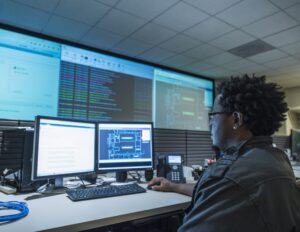School districts all over the country are getting on the technology bandwagon, bringing tablets and Chromebooks into the classrooms and incorporating them into lesson plans. The devices are often used to access online resources including Google Docs and the like, resources that educators have come to rely on as much as the text books of our youth.
The proliferation of devices in schools is driving the need for increased bandwidth forcing schools to look at their wireless infrastructure. The same wireless infrastructure that supported one or two wireless devices used by teachers in the classroom cannot be expected to handle the traffic generated from an entire roomful of students, each armed with an iPad or Chromebook. Many of the school districts we’ve spoken to are upgrading their wireless infrastructure to offer sufficient bandwidth.
As you upgrade the switches or routers supporting the wireless infrastructure, check to see whether they are connected to an uninterruptible power supply (UPS). A UPS can provide backup power that enables the devices to stay connected even during a power disturbance or outage. Just as important, they also provide “clean” power, taking care of any power surges, jitter and such, which can damage sensitive IT equipment. Such anomalies are not uncommon in a large building such as a school. If the school has air conditioning, for example, whenever it kicks on that is likely to cause a rather dramatic power fluctuation. The UPS will make sure switches and routers are protected and available.
The next question is, how old are your UPSs? A typical UPS is designed to last 10+ years depending on factors such as how often it needs to go to battery and the environment in which it’s housed. Most manufacturers recommend replacing the battery at least once over the lifecycle of the UPS. Many UPS’s have lights that indicate the health of the battery, including a “replace battery” light. A common problem is the UPS and the rest of the IT equipment in schools are often in a location where nobody looks at it, so make a point to do so. Some of the Network UPS’s come with management software that enables you to monitor their health remotely.
If it’s been awhile since you’ve replaced the battery or didn’t replace the UPSs during your latest technology refresh you may want to consider a new one. The newer UPS models typically offer more power, in terms of watts per volt-amp, and are more energy efficient. (APC by Schneider Electric even has some models that are Energy Star rated.)
For school districts that are requesting federal assistance for their Network Connectivity projects through E-Rate, UPSs are listed as an eligible product within this program. Make sure to include the appropriate UPS in your proposal when submitting for funding.
Switches and routers don’t draw a lot of power, so a correctly sized UPS can keep your students engaged and connected through a power outage of 30-60 minutes, which is typically enough to ride through the outage. What’s more, a UPS will also protect your investment in networking gear, keeping it safe from brownouts, surges and other potentially damaging electrical events.
To find the UPS that’s right for your application, visit www.apc.com or contact your preferred APC partner!
For more information on APC by Schneider Electric solutions for K-12, download this brochure.



